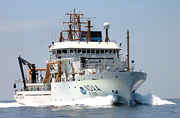Fall 2011
TWELVE YEARS AGO, when the Northeast Consortium began, New England fisheries looked radically different than they do today. In a word, back then the fishing industry was a wreck; stocks were heavily overfished, restrictions were being imposed and fishermen were being shut out from some of the places they had traditionally fished. Quotas and days at sea were reduced, and economic hardship was on the rise.
So for an industry that perceived itself to be the most heavily regulated in the country and was suspicious of intervention from "outsiders," attempting to team fishermen up with scientists in such a dismal climate might have seemed like a crazy idea.
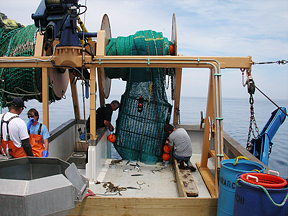 |
|
| Testing a grate to keep dogfish out of a whiting trawl. Photo by David Chosid, Mass. Div. of Marine Fisheries. |
|
"You see the most innovation and creativity when people bump up against something that is completely unpalatable," says Glass, a professor in the Ocean Process Analysis Laboratory. "Like when you tell people a fishery will be closed down unless they do something different. That's when you see the most creativity."
When it began in 1999, the Northeast Consortium was itself a highly creative and innovative effort to encourage and fund effective, equal partnerships among commercial fishermen, scientists, and other stakeholders to engage in collaborative research and monitoring projects in the Gulf of Maine and Georges Bank. The consortium is comprised of four research institutions – UNH, the University of Maine, Massachusetts Institute of Technology, and Woods Hole Oceanographic Institution – working together to foster this initiative.
More than a decade later, New England fisheries are in much better shape, and scientists and fishermen are firmly established in a cooperative partnership that has helped lead to this improvement. Moreover, the Northeast Consortium "template" is being replicated elsewhere around the globe and, most recently, helped encourage partnerships between fishermen and those who regulate them for the very first time. (See sidebar story "NOAA's Henry B. Bigelow: Getting Both Fishermen and Regulators Onboard.")
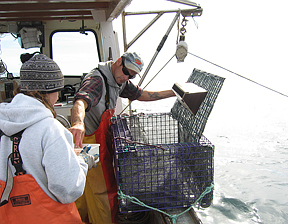 |
|
| Modifying a lobster trap to sample juvenile shrimp. Photo by Chris Manning, UNH-EOS. |
|
At the heart of this progress is the trust that has been slowly cultivated over the years between historically disparate partners.
Says Glass, "Through the years the consortium has achieved a great deal and at many different levels, but the one biggest achievement I think has been the building of trust between the industry and the scientific community."
He adds, "Some people may dismiss that as being too warm and fuzzy, but if you look at all the things we've been able to get done regionwide, for example, the changes in regulation, how we manage things, the data we now provide to the Fisheries Service to help manage stocks – without the trust building and engagement from all the stakeholders none of that would have been possible."
Essentially, the effort offered a carrot to an industry beset with troubles rather than waving a big regulatory stick as a means of bringing back the fish – the latter being a Draconian approach that Glass says he doesn't necessarily subscribe to. And indeed, this is a perfect example of a creative approach being used to drive innovation in the face of unpalatable consequences, and one that forced a change not only on the part of the industry but on the part of the scientific community as well; both camps ultimately realized there were opportunities for partnering.
"It wasn't always easy at the start," Glass notes, "the scientific community had to learn how to work with the industry more effectively and the industry had to learn they didn't need to be scared of the scientists, that we've got a lot to offer each other. And what we found was that once you begin to make those connections it becomes a fertile area for getting things done."
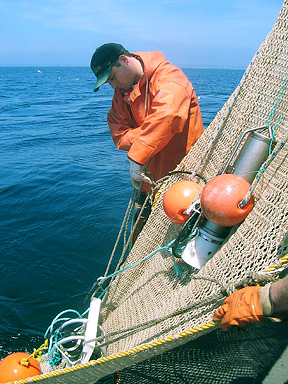 |
|
| A fisherman installs an underwater camera on this shrimp trawl net. Photo by Pingguo He, UNH-EOS. | |
That fertile ground has moved to various spots around the globe where the Northeast Consortium approach has been adopted and adapted. In Holland, for example, researchers familiar with the consortium's method of involving fishermen in developing new strategies for fishing ultimately led Dutch scientists and fishermen to get together in local area "knowledge circles," in which fisherman meet with scientists and managers to talk about their issues and try to develop ways of solving problems.
"It's led to nearly an explosion of creativity in how they run their fishing operations. It hasn't solved all problems by any means, but I see that as being the way forward," Glass says.
Big thinking
Glass also sees what he calls "big thinking" as the only way the fishing industry will be able to go forward in a sustainable way. This is in the realm of think-tank work, which doesn't necessarily come up with specific answers but, rather, poses questions that make people think expansively and creatively about what they're doing – fishing in this case – how they're doing it, and how they could continue to do it in some fashion in the future.
"Conceptually, for example, what we need to be doing is asking things like, Are the species we're focused on now the most appropriate species for the future? Are the fishing methods we use now the most appropriate for the future?"
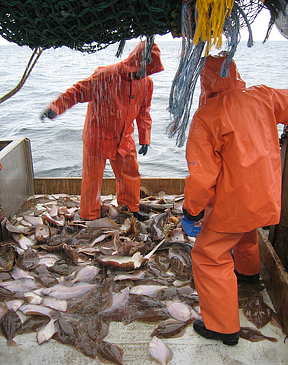 |
|
| Counting species in the catch. Photo by Rachel Feeney, UNH-EOS |
Big thinking would put a big spotlight, for example, on the appropriateness of continuing to fish using a century-old design like trawl gear, which has increased impact on the sea bottom and its inhabitants using today's bigger engines and stronger twines.
"It's a hundred years later and we're still using this same fishing method," Glass says. "If someone came from another planet, didn't know anything about fishing, and was asked to come up with a method to harvest fish from the ocean, they might dream up something radically different."
Indeed, some of the big thinking going on right now isn't being done by aliens but seems otherworldly for sure.
According to Glass, there are a number of initiatives looking at using laser light or other sensory stimulation devices to herd or aggregate fish. It's not farfetched, he asserts, to think about replacing most of a trawl net with non-physical structure such as a system of lasers that might form a visual lattice to create the illusion of a net to catch fish virtually. Such a high-tech approach would have no impact on the seafloor and could potentially be more species-selective thereby cutting down on bycatch and waste.
"This is all conceptual stuff but people are starting to experiment with things like this. It's a long way off but I think we need to have people who are thinking along these lines right now," Glass says. "There are actually some initiatives in other parts of the world, for example, that would use large enclosures on the seafloor with a system of runway-like lights to attract fish into these pens. The fish basically catch themselves."
Fueling a radical shift in fishing
A little less "out there" but still involving big thinking, were discussions about global fisheries issues Glass was invited to participate in last summer at the Southeast Asian Fisheries Development Center (SEAFDEC) conference in Thailand.
With delegates from all over Southeast Asia, and under the banner of "Fish for the People 2020: Adaptation to a Changing Environment," the conference tackled the issue of food security in the context of global warming and rising ocean temperatures, sea level rise, and escalating fuel costs, among other things.
"One of the themes of my presentation was that of ballooning fuel costs and the notion that what we'll be fishing for, and how we'll be fishing ten to fifteen years from now will likely be very different from today," Glass says.
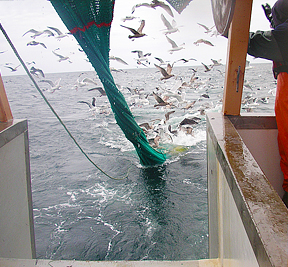 |
||
| An experimental trawl net being hauled back into the boat. Photo by David Chosid, Mass. Div. of Marine Fisheries. |
||
He adds, "If fuel costs double in the next five years, which is not unlikely, that sets the framework for how we position ourselves both with regards to fisheries science and also with what fisheries we're going to pursue and how we pursue them. It's likely to move us away from bulk fisheries to high-quality, high-price species, and in order to do that we're probably going to have to fish differently using different methods."
But at the heart of Glass's SEAFDEC presentation was this notion of thinking outside the box. That is, rather than focus on specific aspects of fisheries, the industry, scientists, and regulators need to be thinking in a more holistic manner about the whole process of fishing.
Even at the level of the Northeast Consortium, Glass asserts, the thinking needs to encompass the bigger picture if sustainable fisheries are to be part of the future.
"The consortium obviously has a geographic mandate, which is the Gulf of Maine and Georges Bank ecosystems, but as part of my role within the International Council for the Exploration of the Sea and as consortium director, it's my job to look at this more global approach."
